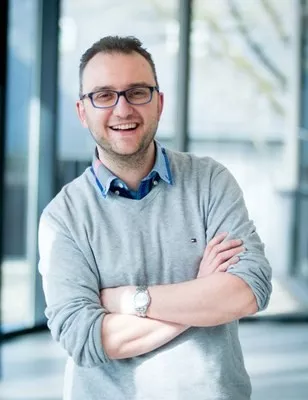Initially, Michaël Lobet wanted to be an astrophysicist to understand the movement of planets and all the mysteries of the universe. An excellent high school physics teacher had given him a taste for these fundamental questions. When he arrived at UNamur with a bachelor's degree in physics, he discovered that physics included many subjects, including optics, which was unknown to him until then. He gradually became fascinated by the phenomena of propagation of the visible light spectrum in materials. With professors Philippe Lambin and Luc Henrard, he discovered numerical modelling. And with professors Jean-Pol Vigneron and Olivier Deparis, he discovered photonics and negative refraction phenomena.
In the footsteps of Harry Potter...
Michaël Lobet then went on an Erasmus trip to Sweden, where he was offered an original research topic: the invisibility cloak.
"Great, for a Harry Potter fan", says the researcher. "That's where I discovered metamaterials and their extraordinary abilities. I discovered that they have properties that allow them to influence the trajectory of light and to bend it at will. Back in Namur, he began a doctoral thesis under the supervision of Professors Henrard and Deparis. "The idea is to use another property of metamaterials to transform them into super-absorbers of electromagnetic radiation, a kind of optical black hole, which is very useful for improving the performance of current photovoltaic cells, for example. And very useful when we want to make something "disappear", or at least give the illusion of it, as with the phenomena of invisibility.
And also Einstein's footsteps...
Einstein said: "It works but we don't know why". The researcher therefore wants to understand. He is therefore interested in everything related to these metamaterials and what can be imposed on light: scattering, emission, absorption, refraction, diffraction, etc. It was after his post-doctorate at Harvard in Professor Eric Mazur's team that the idea came to Michaël Lobet to apply techniques used in electronics to optics.
Two-dimensional materials such as graphene are composed of a single layer of atoms that can be stacked in assemblies of parallel layers. In electronics, the properties of these assemblies are studied by passing an electric current through them to see if they behave in a particular way. This is now also done by twisting the layers slightly, so that they are not completely parallel.
"This is how we discovered superconducting properties in materials made up of graphene sheets that are not perfectly aligned but slightly misaligned or 'twisted'. The aim of the present research project "Twisted optics for slow photon manipulation" is to transfer what is done in electronics to optics. This creates a new field of research - "Twist-optics". We will reproduce these configurations with photonic crystals. We will study the behaviour of light to understand what is going on and, above all, what the potential uses are.

To become a master of light
Light is much more difficult to control than an electric current. We are looking here for what can slow it down, or even what can stop it, and that is precisely the interest of these twisted photonic crystals. Stopping it is a feat for a speeding bullet travelling at over 300 000 km/s! We become masters of light. The light is then trapped but its state is preserved, which is quite different from the phenomenon of absorption, when the light is simply transformed into thermal energy for example. It is 'paused', so to speak. It is therefore possible to imagine improving the characteristics of lasers, improving the performance of quantum computers or even creating optical memories, for example.
Although practical experiments are already feasible, it is more difficult to model these phenomena because this requires very heavy digital resources that do not exist today. This is a recent field and the calculations take several days. Michaël Lobet plans to continue this research with the aim of setting up the numerical techniques needed to refine the knowledge of this emerging field.
It should be noted that in addition to visible light, there is also what is known as non-visible light, including the infrared spectrum linked to heat. The researcher is currently working on another project called PLASMON_EC (PDR FNRS) with Professor Luc Henrard. The aim is to create windows that would be capable of reducing heat loss and thus reduce the energy consumption of buildings. A major societal challenge!
A young father of a one-year-old girl, he enjoys hiking and swimming. Passionate about teaching, he is currently writing a thesis on active pedagogy under the direction of Professor Marc Romainville. And among his hobbies, he finds time to go to ballroom dancing classes with his partner. Maybe he dances the twist, who knows?
bePOM | The Belgian Online Photonics Meetup
Dr Michaël Lobet is one of the founders of the annual bePOM event, together with Dr Sébastien Mouchet, both members of the Namur Institute of Structured Matter (NISM) of UNamur and Dr Gilles Rosolen (UMons). bePOM (Belgian Photonics Online Meetup) aims to strengthen the Belgian network by associating all Belgian universities working in photonics, whether at the level of fundamental or applied research.
